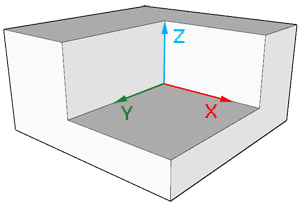- v50 information can now be added to pages in the main namespace. v0.47 information can still be found in the DF2014 namespace. See here for more details on the new versioning policy.
- Use this page to report any issues related to the migration.
40d:Z-axis
(If you're looking for information on the z key, see stocks screen)
The third axis is known in math as the z-axis. It measures "up and down" distances.
It's easy to think of a graph with an x-axis and a y-axis, right?
In the Dwarf Fortress map view, traveling east or west moves you along the x-axis, and traveling north or south moves you along the y-axis. Traveling higher or deeper moves you along the z-axis.
The z-axis, as you can see, is perpendicular to both the x-axis and the y-axis to create a 3D coordinate system, which is what Dwarf Fortress is based in.
Thus, objects described with only two axes are two-dimensional, whilst objects with depth measured along the z-axis are three-dimensional.
The z-axis is believed to be in part of the game engine that calculates accuracy of weapons based on where dwarves are, how missiles fly, and other similar considerations.[Verify]
To move up and down, use < and > (which are shift, and shift.). You can also move up and down using the numpad with shift5 and ctrl5, which is especially convenient for players who use the numpad for horizontal navigation.
In fortress mode
In fortress mode, the right-most column shows your location on the z-axis. Blue is above ground, brown is below ground, and the bright spot in the middle (yellow or cyan) shows the current level. This reflects the elevation profile for the spot the cursor is currently over. Moving up or down will not change the position of the bright marker, but will instead shift the whole bar under it. The number at the top shows how many levels above or below the surface the spot currently is. The number at the bottom is the total elevation of the current level.
See also
- Export local image (map export)
- DF Map Archive - a community site for sharing maps, lets visitors browse vertically through z-levels in exported maps
| Game Basics FAQ | |
|---|---|
| What is the Z-Axis? | |
| What is the point of the game? | |
| Fun | |
| How quickly does time pass in Dwarf Fortress? | |
| Add a question to this FAQ | |
| Back to the Main FAQ | |
